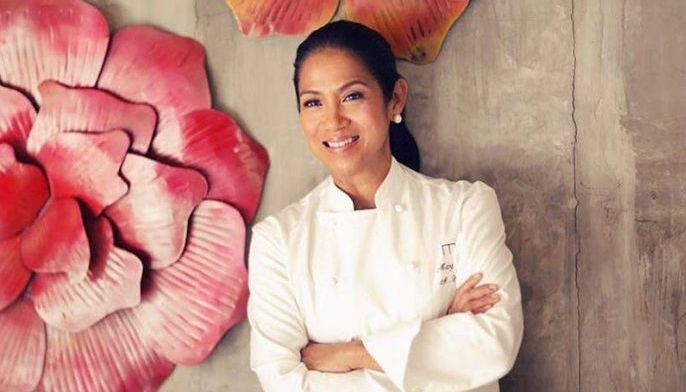Filipino food revolution at KKK
 It’s interesting how acronyms can mean distinct things in different cultures. While KKK in the western world may refer to an organization with strong racist leanings, in Philippine history it stands for a nationalistic movement that sought freedom and a better way of life for Filipinos. Thus, while one would expect redneck cuisine in a restaurant called KKK in the
It’s interesting how acronyms can mean distinct things in different cultures. While KKK in the western world may refer to an organization with strong racist leanings, in Philippine history it stands for a nationalistic movement that sought freedom and a better way of life for Filipinos. Thus, while one would expect redneck cuisine in a restaurant called KKK in the
“KKK really stands for Kainan sa Kalye Kanluran,” explain owners Louie Gutierrez, John Villanueva, Al Purugganan, and Raoul Henson. Together with Analyn Arce, the closely-knit group of friends came up with the name because their first food outlet was located on West (Kanluran) Avenue. The diverse choices, appetizing presentation, and pricing of food in the restaurant could be taken as a reflection of the partners’ various interests and artistic persuasions. Louie designs jewelry, Raoul is a physician specializing in ophthalmologym and John is a businessman. Analyn belongs to the famous ice cream-making family and Al is an erstwhile college professor. The common denominator, says Louie, is that the fun-loving group enjoys good food and good company. The menu in the restaurant is culled mainly from favorite family dishes, and an extensive network of close friends unselfishly shared other recipes.
While each partner is partial to his favorite dish in the restaurant, Al is the passionate cook whose domain is the kitchen. “My contribution to the menu is to add an Asian twist to Filipino cooking,” he says. “I thought that these would have been the original flavors had we not been colonized and influenced by the West.”
Thus, the food at KKK may also be considered revolutionary because it somehow seeks to explore alternative paths that our food history could have taken. Still, says Al, “The spirit and the elements are still very Pinoy. We put the old and the new together and make sure that the essence is very Filipino.”
Indeed, even the restaurant’s decor uses indigenous materials commonly used in traditional Filipino homes. Slender sticks of arurug, commonly used in provincial homes for fencing, are a prominent design element. An eye-catching mural in sepia tones covering one wall is a reproduction of a photograph featuring historical figures Jose Rizal, Felix Hidalgo, J. Pardo de Tavera, and Juan Luna. As in a typical Filipino home, where the attention of visitors is captured by an engaging hodgepodge of details, diners at KKK have many interesting things to look at and talk about while they wait for their food.
The food does not disappoint either. One can understand why inihaw na liempo bacon cut (P229.60) is a best-seller. The boneless strips of pork are tender and perfectly marinated so that they are just the right degree of salty and sweet. The even caramelization of the meat indicates that grilling was done over a controlled flame, and that someone in the kitchen took the effort to make sure that no singeing occurred. Bistek flakes (P190.40) or crisp shredded beef served with tomatoes, onions, and a tasty beefsteak sauce was the perfect accompaniment to hot and steaming rice.
Ensaladang inihaw na talong or eggplant that came with onions, tomatoes, and salted egg is a simple dish that went well with lechon kawali (P218.40). The latter could also be served binagoongan, as tinokwa’t baboy with soybean cake, or with other healthy vegetables such as sliced green mangoes, firm, ripe red tomatoes, and faintly sweet bagoong Balayan. Pla pla na inihaw sa asin is reminiscent of how we cook fish in the farm during harvest season. Tilapia is encased in a thick covering of salt and baked in embers. When the salt has hardened, it is an indication that the fish is ready. The salt casing is cracked open and discarded, and the white flesh of the fish is steaming, moist, perfectly seasoned, and should be eaten immediately.
There is traditional kare kareng baka, cooked as I like it with a thickening agent of ground roasted peanuts and rice, and other favorites like crispy pata, chicken inasal and laing sa gata. It is not surprising that sinigang na lechon is another favorite. The delicious sour broth goes well with crispy lechon.
We were eager to taste the “revolutionary” fare but were waylaid by the familiar Filipino favorites. Future visits will have to be devoted to trying garlic pusit cooked with oyster sauce, wansuy (cilantro) and garlic; lechon manok cooked with pineapple and curry; beef a la KKK (beef with red curry paste), and other dishes with an Asian twist. That can only happen if we are able to resist newfound favorites: hito (catfish) with a delicious, clean-tasting shrimp buro and sinangag sa tinapa at itlog na maalat. The fried fish with tinapa is perfect for those of us who, being oftentimes too harried with crazy schedules, or too lazy or to pick out the tiny fish bones, have to forego the treat.
* * *
KKK Food Revolution has branches at Level 3, Robinsons Place Midtown Wing, Ermita, Manila (tel. no. 567-2186); 1126 Entertainment Mall, SM Mall of Asia, Bay Boulevard, Pasay City (556-0755); and 74 West Avenue, Quezon City (371-9099).



















